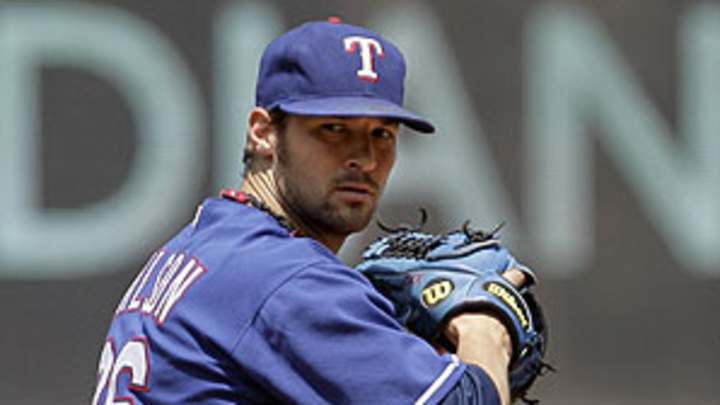Walk-year effect is minimal and about more than just numbers

As is usually the case, the promise of a huge offseason payday is causing some players to have brutal seasons. Before a wrist injury put him on the shelf for six weeks, Albert Pujols had put up two of the worst months of his career on his way to career lows in batting average, OBP and SLG. A's leftfielder David DeJesus has collapsed to .229/.313/.358, in advance of his free agency. J.D. Drew, who battled the pressure in 2004 and 2006 to put up huge numbers, has been one of the few dark spots for the Red Sox: .230/.329/.331. It seems once again that the prospect of getting paid is too much for major leaguers.
I kid, of course. The conventional wisdom is that players find a higher level of success in their "walk year," putting up big numbers so that they can hit the market as a valuable property. No one associates impending free agency with failure, even though it happens fairly often. Everyone remembers that Adrian Beltre signed a one-year deal with the Red Sox after 2009 and went nuts, hitting .321/.365/.553 and earning an $80 million contract with the Rangers. Less well remembered is that Beltre's walk year in 2009 featured a .304 OBP, a .379 SLG and two stays on the disabled list. Andruw Jones went from 41 homers in 2006, the year prior to his walk year, to 26 -- and a .222 batting average -- during it. Last year, Derek Jeter had the worst season of his life as he prepared to become a free agent for the first time.
The data indicates that there is a small walk-year effect, particularly for hitters. Gary Huckabay's 2003 study found that hitters approaching free agency outplayed their projections by a small amount, but that the effect was not apparent for pitchers. In the 2006 book Baseball Between the Numbers, Baseball Prospectus' Dayn Perry concluded that the walk-year effect was real, and manifested itself as much in increased playing time as in improved performance.
Of course, this discussion isn't about percentage-point boosts in OBP, or three extra homers on average, or avoiding the DL a bit more frequently. This is about the frustration felt by fans when a player who has muddled through some seasons suddenly finds himself playing better, and more often, than he has before -- with a new contract months away. It's about the frustration felt by a new team when that player fails to meet the expectations of the walk-year performance and the new, inflated salary. It's an emotional point, rather than an analytical one, and highly cynical -- it essentially states that money motivates players in a way that nothing else does.
The conversation in this regard has always been driven more by anecdote than by data. We remember not only the stars that raised their game on their way to a payday, but the scrubs who had their one shining moment. The player, however, isn't so much the problem as MLB management, which so often looks for any reason to believe. Any careful reading of Gary Matthews' Jr.'s 2006 season would have led to the conclusion that he was a career fourth outfielder who had a fluky year on balls in play with no change to his skills. The Angels read less carefully, signed him to a $50 million contract and are paying him $10 million this season. Matthews is out of baseball, but the legend -- and the salary -- lives on.
The concept that players play best when motivated by potential free agency is as much a tale of managerial failure as it is one of player psychology. Front offices want to blame the player for failing to meet their expectations, rather than consider that the expectations were out of line. The eight-year, $136 million contract the Cubs gave Alfonso Soriano after his 40-40 season in 2006, just to name one deal, was a team taking walk-year performance as a given when that had never been the player's performance level. Teams make poor choices -- the Yankees with Rafael Soriano, the Giants with Barry Zito -- and find it very easy to get fans to believe that the problem is the player.
Finally, free-agent contracts that work out get very little attention. The first Alex Rodriguez contract saw the player continue to the best player in baseball -- while getting blamed for everything wrong with his team -- for three seasons. Mark Teixeira and CC Sabathia have been durable and productive in their three years in New York after signing two of the most lucrative contracts in baseball history. The Red Sox got Hall of Fame-caliber performance and two World Championships in part by investing in Manny Ramirez. There was no walk-year effect; these players were great, they hit the market off a big year and they continued to play championship-caliber baseball.
So as you marvel at the work being done by Prince Fielder, Jose Reyes and C.J. Wilson, all playing for new contracts and having big years, remember that they're just half the story. Edwin Jackson is sputtering along; Jimmy Rollins hasn't bounced back to his All-Star self. Jonathan Broxton is having the worst year of his career and is now sidelined by injury. The walk-year effect may be real in the aggregate, but at the individual level it's far from a magic wand that produces big seasons out of nowhere.

Joe Sheehan has been contributing to Sports Illustrated and SI.com since 2007. Prior to that he was a founding member of Baseball Prospectus and a contributor to ESPN.com. He's been a regular guest on ESPNews' "The Hot List", MLB Network's "Clubhouse Confidential" and "Fantasy 411", and "SportsTalk" on the NBC Sports Network. He's probably talking baseball on the radio somewhere right now. A graduate of the University of Southern California, Joe lives in New York.